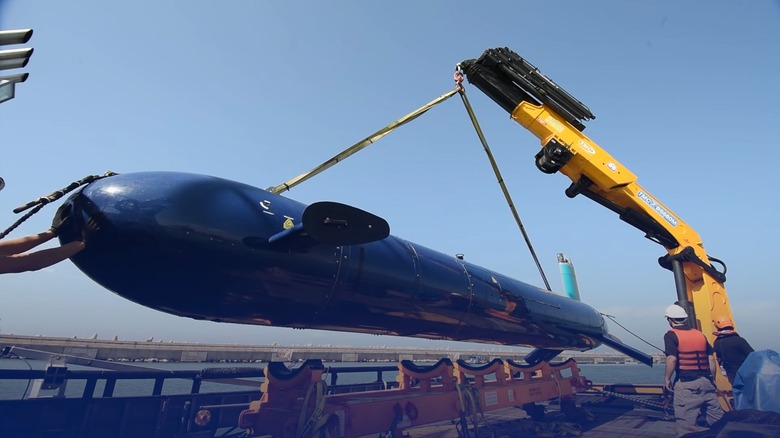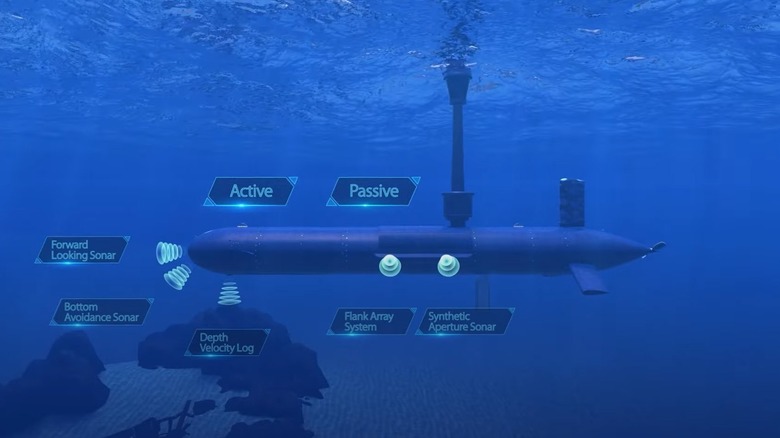The German Navy Is Testing A New Unmanned Underwater Drone
When most people think of Germany's military, it's unlikely they picture the nation's navy, given how much its army is covered by the press on the world stage. This is due to its size, which is infinitesimally small when compared to the United States Navy, which has a submarine fleet larger than the entire German Navy in terms of ships. Regardless, Germany's Navy, called the Deutsche Marine, boasts around 34 ships and 56 aircraft. Despite its size, it remains one of the world's few blue-water navies due to its ability to extend beyond its territorial waters. The Deutsche Marine continues to develop new technologies, making it a powerful player on the world stage.
One such technology involves the use of unmanned underwater vehicles (UUV), which is an emerging tech being developed by numerous countries around the world. Northrop Grumman is developing an underwater Manta-Ray drone for the U.S. Navy, which will be capable of long-term operation anywhere in the world. Germany isn't developing its own UUV in-house, but it is testing a new system developed by Israel's defense contractor, Israel Aerospace Industries (IAI) and Elta Systems Ltd., called the BlueWhale. The Deutsche Marine began testing these new UUVs in the Baltic Sea in November 2024, and they show great promise.
The BlueWhale looks very much like a small submarine because that's what it is, but unlike traditional subs, it's uncrewed. This frees up a great deal of space for the UUV's primary mission: Information and intelligence gathering. These relatively small UUVs have widespread collection capabilities that could potentially improve and increase a navy's ability to detect threats in hostile waters for the purpose of anti-submarine warfare (ASW) and acoustic reconnaissance (ACINT). Here's what is known about the BlueWhale thus far.
The BlueWhale UUV
The BlueWhale is smaller than a crewed submarine, but it's not a little ship. It measures almost 36 feet in length and has a diameter of just over three feet. It displaces 5.5 tons of seawater and is packed with all kinds of active and passive measurement devices. The BlueWhale can travel at around 7 knots (8 mph) while submerged to a depth of 984 feet, which is relatively deep for a military submarine with an endurance of between 10 and 30 days. Its capabilities include visual intelligence (VISINT), communications intelligence (COMINT), and more.
It features a watertight mast capable of being used for surface payload, which can utilize a variety of sensors, enabling real-time broadband satellite communications (SATCOM) anywhere in the world. The sensors carried can vary, and the Deutsche Marine hasn't revealed what specifically it tested, though anti-submarine warfare is its stated goal. To accomplish this, the BlueWhale would need to carry active and passive Flank Array Sonar (FAS), which is used to detect surface and subsurface vessels.
Active Towed Array Sonar (TAS) could also be used as an underwater sensor alongside a Synthetic Aperture Sonar (SAS), which is used to detect naval mines and map the seafloor. All of this equipment and technology comes together to create a vessel capable of finding, fixing, and relaying the location of enemy submarines, surface vessels, and mines in real-time to Deutsche Marine command in support of its Marine 2035 and Beyond strategy. IAI and Atlas Elektronik unveiled the system in May 2023, and it's shaping up to be the future of naval intelligence collection.

